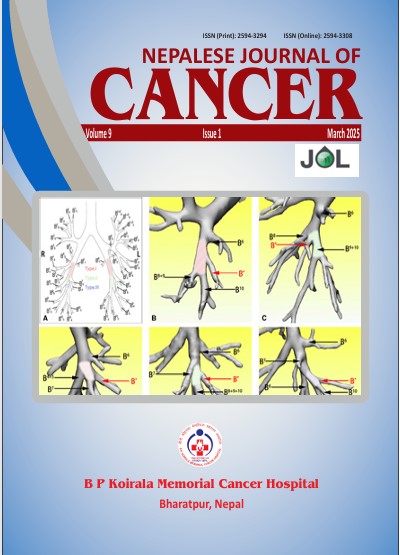Pattern of the lymph node metastasis in esophageal and gastroesophageal junction cancers undergoing surgery in tertiary care cancer in Nepal
DOI:
https://doi.org/10.3126/njc.v9i1.77004Keywords:
lymph node, esophagectomy, gastric cancer, esophageal cancerAbstract
Background: Esophageal carcinoma (EC) and Gastroesophageal junction carcinoma (GEJ) is characterized by a high frequency of lymph node metastasis. Metastatic lymphatic mapping is important to determine the optimal extent of the radiation field in case of chemoradiotherapy and lymphadenectomy when esophagectomy is indicated. The objective of this study is to identify the distribution pattern of metastatic lymphatic spread in relation to tumor location of esophageal and GEJ cancer.
Methods: The study group comprised of 528 patients between year 2001 and 2023 who underwent en bloc removal of tumor with radical lymphadenectomy. Nodal stations were numbered as per Japanese classification of esophageal cancer. Location of tumor in particular segment of thoracic esophagus and GEJ has been done as per AJCC/ UICC 8th edition.
Results: Total number of lymph nodes (LN) dissected were 11566 average 22 LNS from each patient and 2268 LNs were positive. Esophageal squamous cell carcinoma (ESCC) and adenocarcinoma were found in 278 (52.6%) and 242 (45.8%) patients, respectively. Out of 528 cases, 17 cases were of upper thoracic esophageal carcinoma with highest lymph node metastasis (LNM) to lower mediastinal nodes 59 %, 149 patients were belonged to group of middle thoracic esophageal carcinoma with common LNM to middle mediastinal nodes 55 %, 159 cases siewert type I and 203 cases of siewert type II both have highest LNM to abdominal nodes 61 % and 91 %, respectively. Upper abdominal nodes were involved in 11%, 29% and 61% in upper, middle and GEJ - I tumors, respectively. Middle mediastinal nodes were involved in 2% cases of GEJ - II tumors.
Conclusion: Certain pattern of nodal metastasis exists for esophageal and GEJ cancers. For any location of thoracic esophageal cancer, upper abdominal nodes along with mediastinal need to be excised whereas for GEJ II, middle mediastinal nodal dissection may be safely omitted.
Downloads
Downloads
Published
How to Cite
Issue
Section
License
Copyright (c) 2025 Nepalese Journal of Cancer

This work is licensed under a Creative Commons Attribution 4.0 International License.
This license lets others distribute, remix, tweak, and build upon your work, even commercially, as long as NJC and the authors are acknowledged.
Submission of the manuscript means that the authors agree to assign exclusive copyright to NJC. The aim of NJC is to increase the visibility and ease of use of open access scientific and scholarly articles thereby promoting their increased usage and impact.




